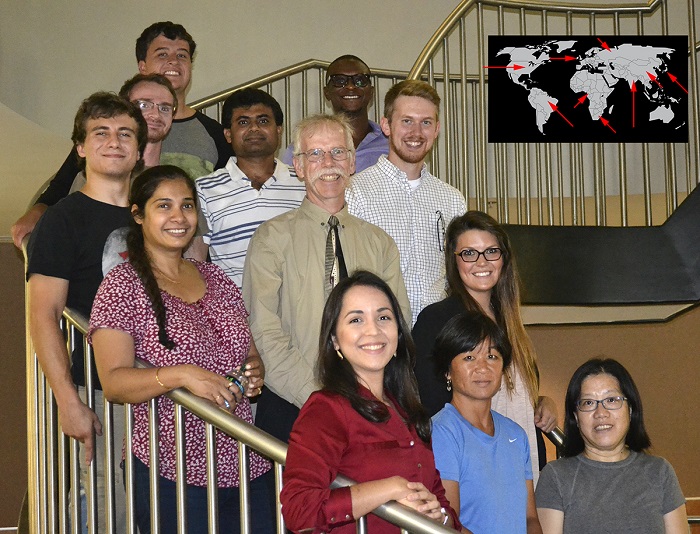|
Additional Contact Information: Department of Biomedical Sciences |

RESEARCH/TEACHING INTERESTS
NEUROPROTECTION AND NEUROGENESES AFTER SCI AND STROKE
The Hagg lab investigates how novel neurotrophic mechanisms and endogenous stemcell might be used to develop CNS repair strategies. We are currently identifying molecular signaling mechanisms and testing small molecules that activate neuroprotective mechanisms might be used to reduce tissue loss after an ischemic stroke injury. We focus on astroglial and endothelial/microvascular mechanisms that protect as well as those that lead to detrimental inflammation in the injured brain regions. Secondly we are identifying molecular regulators of endogenous neural precursors in adult rodents which can be targeted for enhancing neurogenesis and redirect neuroblast migration towards stroke injuries. The long term goal of these studies is to provide information that would lead to better treatment strageties for a variety of human neurological disorders, including spinal cord injury and stroke. Techniques used routinely include various refined microsurgical procedures in the brain and spinal cord of adult rats and mice, pharmacological treatments, regular and confocal immunohistochemistry, Western blotting and real-time PCR.
LABORATORY PERSONNEL
Matt P. Keasey, PhD, Research Assistant Professor
Chiharu Lovins, MSc, Director of Research
DEL Lovins, Technician
Grace Hartman, Technician
Cuihong Jia, PhD, collaborator, Assistant Professor
We are always looking for excellent people.
Come join us!
ACTIVE RESEARCH FUNDING
NIH R01AG029493 "Targeting CNTF to increase adult forebrain neurogenesis"
NIH R01NS102745 “Targeting blood-derived integrin signaling after stroke”
PUBMED
Complete List of PubMed Publications
SELECTED PUBLICATIONS
Jia C, Gill D, Lovins C, Brown RW, Hagg T (2022) Female-specific role of ciliary neurotrophic factor in the medial amygdala in promoting stress responses. Neurobiology of Stress 17:100435. PMID 35146079, PMC8819478
Keasey MP, Razskazovskiy V, Jia C, Peterknecht ED, Bradshaw PC, Hagg T (2021) PDIA3 inhibits mitochondrial respiratory function in brain endothelial cells and C. elegans through STAT3 signaling and decreases survivial during ischemia. Cell Communication and Signaling 19(1): 119 PMID: 34922569, PMC8684072
Jia C, Oliver J, Gilmer D, Lovins C, Rodriguez-Gil D, Hagg, T (2020) inhibition of focal adhesion kinase increases adult olfactory stem cell self-renewal and neuroregeneration through ciliary neurotrophic factor. Stem Cell Research 49:102061. PMID: 33130470 PMC7903807
Jia C, Malone H, Keasey MP, Lovins C, Elam J, Hagg T (2020) Blood vitronectin induces detrimental brain IL-6 and correlates with outcomes after stroke only in female mice. Stroke 51(5):1587-1595. PMID 32312218, PMC7249257
Jia C, Keasey MP, Malone H, Lovins C, Hagg T (2020) Vitronectin mitigates stroke-increased neurogenesis only in female mice through FAK-regulated IL-6. Experimental Neurology 323:113088. PMID 31678139, PMC6901344.
Jia C, Keasey MP, Malone H, Lovins C, Sante RR, Razskazovskiy V, Hagg T (2019) Vitronectin from brain pericytes promotes adult forebrain neurogensis by stimulating CNTF. Experimental Neurology 312:20-32. PMID 30408465, PMC6326873.
Jia C, Keasey MP, Malone H, Lovins C, Hagg T (2018) Inhibition of astrocyte FAK-JNK signaling promotes subventricular zone neurogenesis through CNTF. Glia 66(11):2456-2469. PMID 30500112 PMC6863602
Keasey MP, Jia C, Pimentel LF, Sante RR, Lovins C, Hagg T. (2018) Blood vitronectin is a major activator of LIF and IL-6 in the brain through integrin-FAK and uPAR signaling. Journal of Cell Science 131(3):jcs202580, PMID 29222114, PMC5826040
Banerjee K, Keasey MP, Razskazovskiy V, Visavadiya NP, Jia C, Hagg T (2017) Reduced FAK-STAT3 signaling contributes to ER Stress-induced mitochondrial dysfunction and death in endothelial cells. Cellular Signaling 36:154-162. PMID 28495589, PMC5589129
Visavadiya NP, Keasey MP, Razskazovskiy V, Banerjee K, Jia C, Lovins C, Wirght GL, Hagg T. (2016) Intergrin-FAK signaling rapidly and potently promotes mitochondrial function through STAT3. Cell Communication and Signaling. 14(1):32. PMID 27978828, PMC5159999.
 Stout Drive Road Closure
Stout Drive Road Closure 